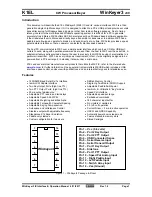
■ Software reset (SYSRESREQ)
■ Software peripheral reset
■ Watchdog reset (if configured as a system reset in the
RESBEHAVCTL
register)
■ MOSC failure reset
■ BOR reset (if configured as a system reset in the
RESBEHAVCTL
register)
■ External reset (if configured as a system reset in the
RESBEHAVCTL
register)
■ Writes to the
HSSR
register
The
WORKING
bit of the
EEDONE
register can be checked before the reset is asserted to see if an
EEPROM program or erase operation is occurring. Soft resets may occur when using a debugger
and should be avoided during an EEPROM operation. A reset such as the Watchdog reset can be
mapped to an external reset using a GPIO, or Hibernate can be entered, if time is not a concern.
Endurance
Endurance is per meta-block which is 8 blocks. Endurance is measured in two ways:
1.
To the application, it is the number of writes that can be performed.
2.
To the microcontroller, it is the number of erases that can be performed on the meta-block.
Because of the second measure, the number of writes depends on how the writes are performed.
For example:
■ One word can be written more than 500K times, but, these writes impact the meta-block that the
word is within. As a result, writing one word 500K times, then trying to write a nearby word 500K
times is not assured to work. To ensure success, the words should be written more in parallel.
■ All words can be written in a sweep with a total of more than 500K sweeps which updates all
words more than 500K times.
■ Different words can be written such that any or all words can be written more than 500K times
when write counts per word stay about the same. For example, offset 0 could be written 3 times,
then offset 1 could be written 2 times, then offset 2 is written 4 times, then offset 1 is written
twice, then offset 0 is written again. As a result, all 3 offsets would have 4 writes at the end of
the sequence. This kind of balancing within 7 writes maximizes the endurance of different words
within the same meta-block.
8.2.4.2
EEPROM Initialization and Configuration
Before writing to any EEPROM registers, the clock to the EEPROM module must be enabled through
the
EEPROM Run Mode Clock Gating Control (RCGCEEPROM)
register (see page 400) and the
following initialization steps must be executed:
1.
Insert delay (6 cycles plus function call overhead).
2.
Poll the
WORKING
bit in the
EEPROM Done Status (EEDONE)
register until it is clear, indicating
that the EEPROM has completed its power-on initialization. When
WORKING
=0, continue.
June 18, 2014
620
Texas Instruments-Production Data
Internal Memory
















































